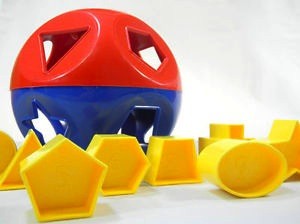When practicing medicine is like playing with a Shape-O toy, and what to do about it.

You have probably seen this toy before. It’s the Tupperware Shape-O, a tool for teaching toddlers how to match shapes to the holes they fit in. It reminds me of how new doctors learn to recognize illnesses based on their characteristics. Sore throat, fever, swollen glands: ah, that’s strep throat! Fatigue, weight gain, constipation, feeling cold—must be hypothyroidism! With as much enthusiasm and delight as a young child finding the right hole into which to insert the triangle or the square, we learned in medical school to recognize the patterns that would lead to a successful diagnosis.
There are some parts of our medical system for which this works well. For example, in crisis-based medicine such as emergency care for trauma or stroke, quick pattern recognition and the algorithms that follow can be life-saving. Unfortunately, not all patients are easily categorized. What happens if the patient is an octagon, and our Shape-O doesn’t have an octagonal hole? If we are not very good doctors, we may criticize the patient for not conforming to our understanding of illnesses. We may patronizingly refer them to Psychiatry, since our inability to identify their shape must mean that the shape they describe does not really exist. If we are good doctors, we tell the patient that we are just not smart enough to figure them out. We then refer them to a specialist or to a larger institution—hopefully, one whose Shape-O has more holes in it than ours does—to identify the cause of their suffering.
Here’s a perfect example of the Shape-O limitations: for years, we have treated hypothyroidism with a medication called levothyroxine, or T4. T4 is the reservoir form of the thyroid hormone, and it is converted into T3, the more active form of thyroid hormone, in our tissues. A subset of patients still complained of symptoms of low thyroid despite a normal TSH (thyroid stimulating hormone) and T4. Many were told that their symptoms were imagined, since the blood tests must accurately reflect thyroid function. Recently, we have discovered a gene that makes some thyroid patients less able to convert T4 to the more active T3 hormone.[1] Now we are acknowledging that their inability to lose weight, fatigue, and decreased metabolic rate may have a “real” explanation. But since our Shape-O’s did not have a hole shaped like “thyroid patients with persistent symptoms despite normal labs,” we often dismissed these patients and told them they just needed to eat less and exercise more.
So how do we overcome the limitations of the Shape-O approach to medicine? First, we need to acknowledge that medicine is not a neat, always quantifiable science, but a messy, passionate and ultimately more rewarding combination of science and art. It does not lend itself to 10-20 minute visits. In all but the most straightforward acute care situations, the physician needs to establish trust and create a relationship with the patient. Only then can we be sure of the diagnosis and come up with a treatment strategy acceptable to the patient, not just to the doctor. The revered 12th century rabbi and physician Maimonides said, “The physician should not treat the disease but the patient who is suffering from it.” Having knowledge of and the trust of the patient is particularly important for managing chronic conditions such as obesity, diabetes, and heart disease. It is an ongoing and trusting doctor-patient relationship that is most likely to successfully control chronic illness and reduce the need for crisis medicine.
It is also critical to recognize that no one has all the answers. If our Shape-O doesn’t have the right shaped hole, we need to enlist other healers. Sometimes that will be another physician with more expertise in a particular subspecialty, but often it will be a different type of practitioner: the traditional Chinese medicine or Ayurvedic doctor or the homeopath who has a completely different paradigm, the physical therapist or psychologist who can approach the problem from a different perspective, or the functional medicine provider who can dig down into the genomics and biochemistry of the problem. And even if we are spot-on about the shape, we frequently need a cadre of healers to make a patient whole again.
It is my hope and prayer that medicine will move beyond the Shape-O approach to a more sophisticated, compassionate and ultimately more rewarding and effective system of health care.
In health,
Laurie Radovsky, MD
[1] Elizabeth A. McAninch, MD, and Antonio C. Bianco, MD, PhD. The History and Future of Treatment of Hypothyroidism. Ann Intern Med. 2016;164:50-56.